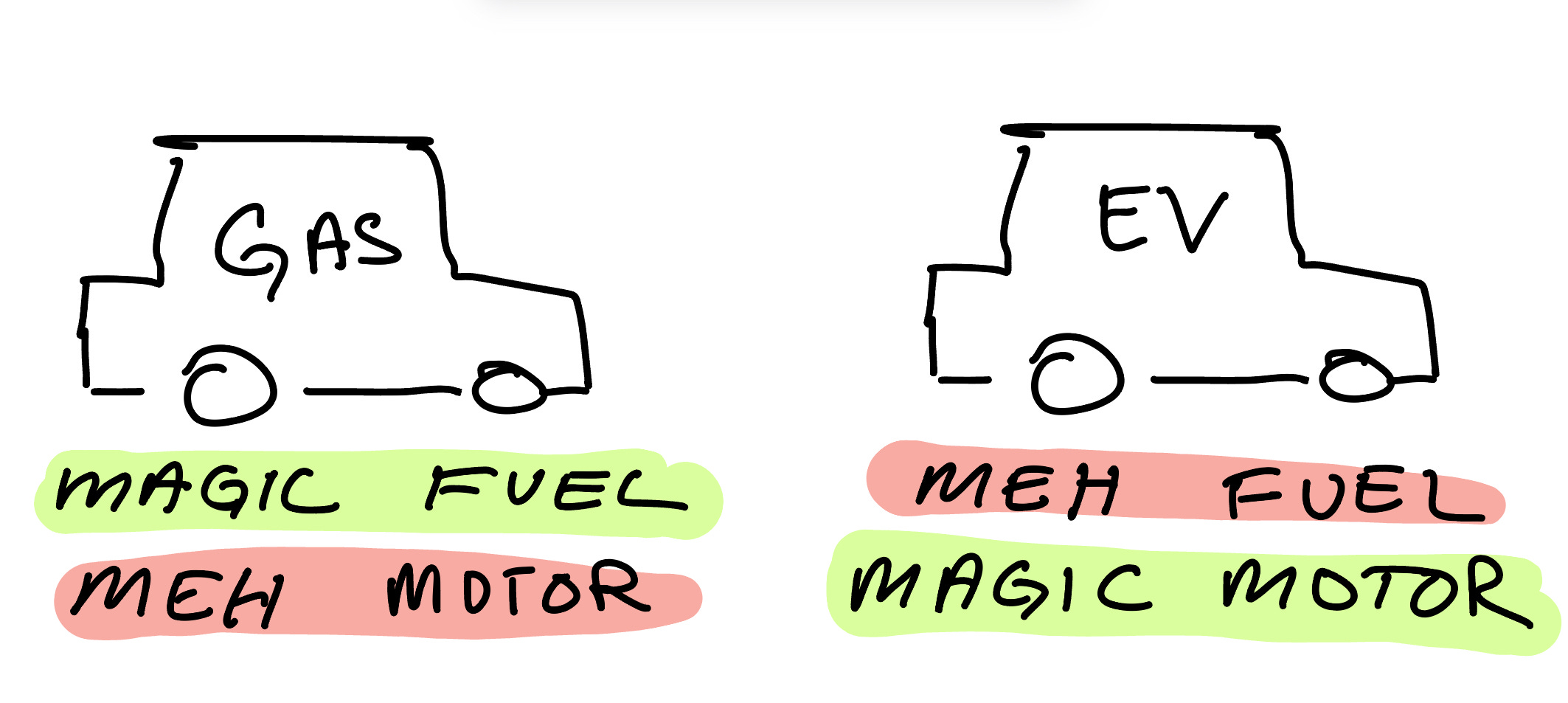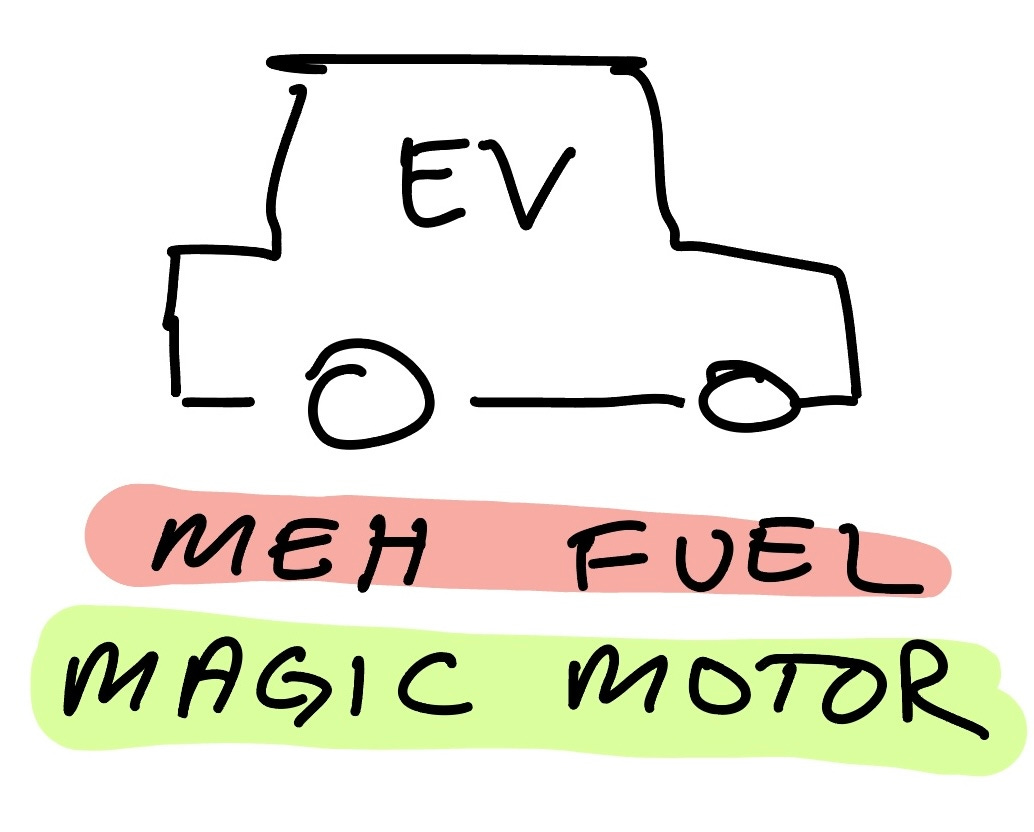Welcome to my newsletter on the electrification of traditionally fossil-fueled stuff. If you were forwarded this post and liked it, please subscribe! We cover 3 things here:
Investments: a company I’ve invested in and why,
Motonerd stuff: how EVs can do things gas can’t, or
Learning science: EV-curious to EV-confident. ←Dec 1-15
It’s Sketchy EV Time: 10 ideas for 2023
Sketch #1 is on Fuel + Drivetrain Basics; catch the the opener here.
Gas vehicles and EVs have fundamentally different solutions to the fuel + drivetrain = vehicle motion equation. Putting a little study time in now should pay big dividends as you move into your first EVs, and later on as EVs start doing things gas vehicles never could.
There’s great nuance and billions in innovation going on all four of these fronts, but the basic science leads us to this starting point for each platform:
Gas: Magic Fuel, Meh Motor
Electric: Meh Fuel, Magic Fuel
Gas: Magic Fuel
It’s hard to argue with the energy density of fossil fuels; it’s kinda their thing. Scientists usually measure it in MegaJoules per kilogram (MJ/kg). Here’s a short list of two fossil fuels and two that aren’t:
Coal: 24-31
Gasoline: 46
Lithium-batteries: 0.5
Doughnuts: 0.08
Let’s convert these scientist units to the one we use every day — gallons. And another we use every day — calories. 1 MegaJoule = 239,000 calories. A gallon of gas weighs 6 Lbs, about 2.7 kilograms. That’s 30 million calories/gallon. Wow.
Speaking of calories, the next New Orleans Doughnut Meetup is this Saturday, Dec 9!
Gasoline is 100X better at storing energy than batteries.
At half a MJ per KG, lithium-ion batteries are 100 times worse than gasoline (46) at storing energy.
Why are fossil fuels so good as smushing so much energy into a given mass or volume?
For millions of years, gravity and intense heat have been smushing (technical term) organic material from dinosaurs, plants and other sources into crude oil and other fossil fuels at planetary scale. I guess if we smushed doughnuts for that long…..
Gas: Meh Motor
So gasoline’s really good at storing energy. How about getting it to the wheels? The best way we’ve found for the vehicles most of us drive is to light it on fire (combustion) in a tiny little cylinder-shaped room (internal) then get some of that energy to the wheels. Here’s how an Internal Combustion Engine (ICE) motor works:
Mix magic fuel with oxygen
Squirt it into a tiny cylinder-shaped room
Smush it
Light it on fire to get:
Heat — which we don’t need, and
Rapid gas expansion — which we can use to make linear motion, if the floor of that tiny room can move when the expanding gas pushes on it
Turn that linear floor motion into rotational energy with a rod connecting the moving cylinder floor to a rotating shaft
Get 4-12 tiny rooms in perfect explosive sync for more power since we’re wasting lots of heat and energy
Find a way to disconnect then re-connect that always-spinning explosion machine to our wheels, which need to go from stopped to slow to fast and back often
Add gears to slow that spinning down by 5-10X to match our desired wheel speeds, but in stages since the explosion machine has a narrow window of max performance
Add more gears to get to the wheels, like making the 90-degree turn from the engine to axles where the wheels are
Constantly circulate oil to up to 2,000 moving parts
As good as the fuel thing is with ICE, the round about way we get that fuel into the wheels means that even today, with 100 years of trying, most ICE vehicles waste 80% of the energy they burn.
If my kid was still in first grade, making 20 on his spelling quizzes at age 100, I’d have to admit it - he’s a meh speeler. Let’s leave it there for now. Magic fuel, meh motor. On to EVs.
EV: Meh Fuel
Remember the energy density chart?
Gasoline: 46 MJ/kg
Lithium-batteries: 0.5 MJ/kg
Lithium-Ion batteries, the most common chemistry found in EVs today, are 100X worse that gas at storing energy. Why?
Gas gets one cool cheat code here. To make gas work, we need to mix it with oxygen before we light it up. But we can just grab the oxygen from ambient air instead of carrying it with us.
With batteries, electrons are our fuel. And the cool thing is they are virtually weightless. It’s the miniature chemistry lab we have to build in each battery that breaks the energy density math.
You know those hotel rooms with the connecting door in between? That’s kinda what the inside of a battery looks like. Two connected rooms, but only the lithium can make it through the door. Electrons have to go out the window through the motor — where they create magnetic fields that spin the rotor — then back in the window on the other side. Meanwhile a team of lithium ions (atoms minus one electron that’s out doing its wire thing) is hustling back and forth through the door to keep charges relatively balanced. And that lithium ion is huge — 13,000 times bigger than the electron we really need to make electricity. Plus we need beds in each room to keep the lithium ions rested til their next move. Every time we want to up capacity by one electron, we’ve got to make room for all that other lab equipment!
As tough as this is, we’re dealing with chemistry here - lots of ways to fine tune, try new materials, mix and match. With ICE, we’re mostly dealing with big hunks of metal; it’s harder to find big breakthroughs. While gas motors have seen only moderate efficiency gains and cost drops in the last few decades, batteries have traveled on steeper curves:
Commercial lithium-ion energy densities have tripled from .3 MJ/kg to 1 MJ/kg in less than 40 years. Some labs have seen 2 MJ/kg.
Battery costs are down 97% in 30 years. Nothing in a gas drivetrain has that kind of scale economics.
There’s no denying it, batteries lose on the pure energy density metric. And this will impact life with EVs. In future sketches, we’ll explore how.
EV: Magic Motor
ICE drivetrains are….complex. Even my simple list has 11 pretty serious steps. Electric drivetrains are beautifully simple.
Here’s the list for electric motors:
Use a sensor to measure where the stator (part that doesn’t spin) and the rotor (part that spins) are compared to each other
Send a pulse of electrons through wound-up wire to create a magnetic field that pushes or pulls one part of the motor away from the other to make it spin
Connect that rotating motor to your wheels
Did you catch the electromagnetic field part? The stator and rotor don’t touch; magnetic fields triggered at just the right time oppose or attract the other side of the motor to create rotational energy—the droids energy we’re looking for.
We’ll go deeper on this a few sketches from now, but if we add some regenerative braking, we can get vehicle efficiencies of 90-94%!
Before we wrap, here’s the tl;dr:
ICE
Magic fuel: Gasoline’s epic energy density means we’ve never really worried about carrying enough fuel. (100X better)
Meh motor: Internal combustion engines burn that fuel in tiny explosion rooms then translate part of that explosive reaction to the wheels through a complex set of moves. (4X worse, 100X more moving parts)
EV
Meh fuel: EVs store electrons in super-tiny vending machines that store 100X less energy than gasoline. (100X worse)
Magic motor: These batteries send perfectly timed electrons through tightly-wound wires to create magnetic fields that make an electric motor’s rotor spin. (4X better, 100X fewer moving parts)
Tomorrow, we’re talking EV adoption and how this design equation has impacted what we’ve been driving over the last 100 years. See you then!
Pop quiz for my to-the-end readers: Drop your answer in the comments; first 3 right answers get a t-shirt! What % of the approximately 4200 cars on the road in the US were electric in the year 1900?








Randy! You are very close, indeed! Today's post for the answer....
I'll say an even third (even though that's odd)